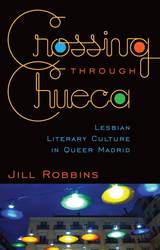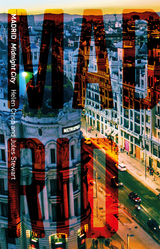4 books about Madrid

Crossing through Chueca
Lesbian Literary Culture in Queer Madrid
Jill Robbins
University of Minnesota Press, 2010
In the past two decades the city of Madrid has been marked by pride, feminism, and globalization—but also by the vestiges of the machismo nurtured during the long years of the Franco dictatorship. Crossing through Chueca examines how lesbian literary culture fares in this mix from the end of the countercultural movement la movida madrileña in 1988 until the gay marriage march in 2005.
Jill Robbins traverses the various literary spaces of the city associated with queer culture, in particular the gay barrio of Chueca, revealing how it is a product of interrelations—a site crisscrossed by a multiplicity of subjects who constitute it as a queer space through the negotiation of their sexual, racial, gender, and class identities. Robbins recognizes Chueca as a political space as well, a refuge from homophobia. She also shows how the spatial and literary practices of Chueca relate to economic issues.
In examining how women’s sexual identities have become visible in and through the Chueca phenomenon, this work is a revealing example of transnational queer studies within the broader Western discussion on gender and sexuality.
[more]

Madrid
Midnight City
Helen Crisp and Jules Stewart
Reaktion Books, 2021
Spain’s top city for tourism, Madrid attracts more than six million visitors a year. In this book, Helen Crisp and Jules Stewart not only place visitor attractions in their historical perspective, relating the story of a city and its people through the centuries, but they also offer carefully curated listings that give a nod to well-known attractions and sites, as well as hidden gems. Spain’s political and art capital, with its “Golden Triangle” of museums and myriad art galleries, Madrid is also a city of dazzling nightlife, with a profusion of cafés and bars. Offering in-depth insight into the history of Madrid along with a view—from fiestas to football—into life in the city today, this is the story of a vibrant, energetic metropolis, one that remains an enigma to many outsiders.
[more]

San Camilo, 1936
The Eve, Feast, and Octave of St. Camillus of the Year 1936 in Madrid
Camilo José Cela
Duke University Press, 1991
Widely regarded as one of the best works by the winner of the 1989 Nobel Prize for Literature, San Camilo, 1936 appears here for the first time in English translation. One of Spain’s most popular writers, Camilo José Cela is recognized for his experiments with language and with difficult subject matter. In San Camilo, 1936, first published in 1969, these concerns converge in a fascinating narrative that is as challenging as it is rewarding, as troubling as it is compelling.
A story of history as it happens, by turns confusing and startingly clear, echoing with news and rumors, defined by grand gestures and intimate pauses, the novel leads the reader into the ordinary life of extraordinary times. Beginning on the eve of the Spanish Civil War, San Camilo, 1936 follows a twenty-year-old student’s attempts to sort out his private affairs (sex, money, career) in the midst of the turmoil overtaking his country. In vivid and richly textured prose that distinguishes Cela’s work, the emotional reality of civil war takes on a vibrant immediacy that is humorous, tender, and ultimately transforming as a young man tries to come to terms with the historical moment he inhabits—and hopes to survive.
Readers new to Cela will find in this novel ample reason for the author’s growing reputation among audiences worldwide.
A story of history as it happens, by turns confusing and startingly clear, echoing with news and rumors, defined by grand gestures and intimate pauses, the novel leads the reader into the ordinary life of extraordinary times. Beginning on the eve of the Spanish Civil War, San Camilo, 1936 follows a twenty-year-old student’s attempts to sort out his private affairs (sex, money, career) in the midst of the turmoil overtaking his country. In vivid and richly textured prose that distinguishes Cela’s work, the emotional reality of civil war takes on a vibrant immediacy that is humorous, tender, and ultimately transforming as a young man tries to come to terms with the historical moment he inhabits—and hopes to survive.
Readers new to Cela will find in this novel ample reason for the author’s growing reputation among audiences worldwide.
[more]

World Film Locations
Madrid
Edited by Lorenzo J. Torres Hortelano
Intellect Books, 2011
From Death of a Cyclist to Open Your Eyes to The Limits of Control, Madrid has graced the big screen countless times across a wide variety of genres enacted by a similarly eclectic array of directors, including Carlos Saura, Luis Buñuel, and Pedro Almodovar. With the aim of capturing the full range of portrayals of the city onscreen, this volume pairs short synopses of scenes from fifty films with an accompanying array of dynamic full-color film stills. These scenes are set in context through a series of incisive essays that examine significant periods from Madrid’s rich film history, as well as its key industry figures and recurring themes.
Packed with fun facts, World Film Locations: Madrid offers a fascinating—and often surprising—tour of the many film representations of Madrid. For jetsetters planning a jaunt to this richly cinematic city, the book also includes photographs of locations as they appear now and city maps with information on how to locate key features.
[more]
READERS
Browse our collection.
PUBLISHERS
See BiblioVault's publisher services.
STUDENT SERVICES
Files for college accessibility offices.
UChicago Accessibility Resources
home | accessibility | search | about | contact us
BiblioVault ® 2001 - 2024
The University of Chicago Press









